Citroen C4 RHD 2014 2.G Owner's Manual
Manufacturer: CITROEN, Model Year: 2014, Model line: C4 RHD, Model: Citroen C4 RHD 2014 2.GPages: 328
Page 131 of 328
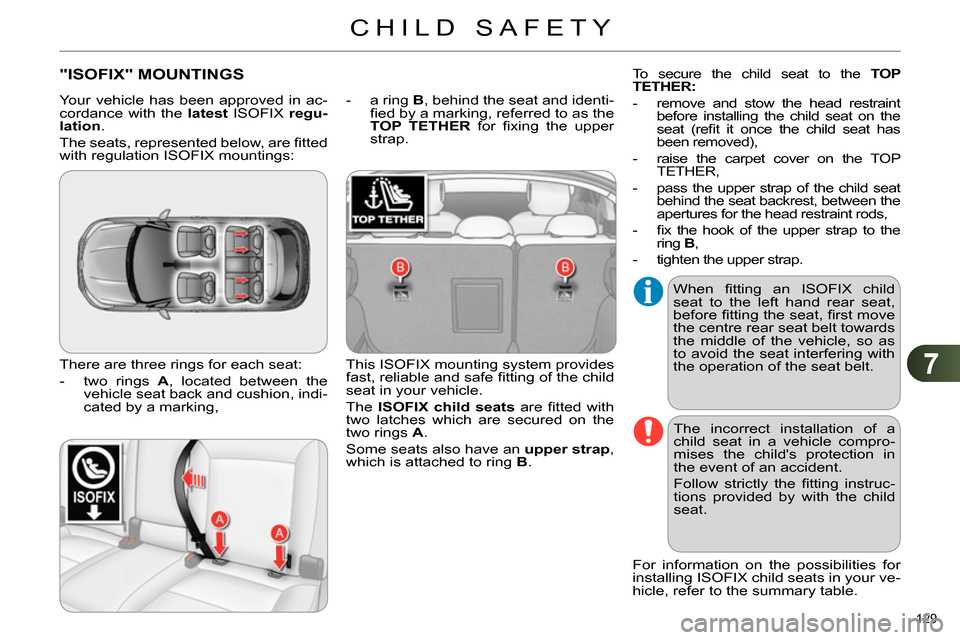
7
CHILD SAFETY
129
"ISOFIX" MOUNTINGS
There are three rings for each seat:
- two rings A
, located between the
vehicle seat back and cushion, indi-
cated by a marking,
- a ring B
, behind the seat and identi-
fi ed by a marking, referred to as the
TOP TETHER
for fi xing the upper
strap.
This ISOFIX mounting system provides
fast, reliable and safe fi tting of the child
seat in your vehicle.
The ISOFIX child seats
are fi tted with
two latches which are secured on the
two rings A
.
Some seats also have an upper strap
,
which is attached to ring B
.
The incorrect installation of a
child seat in a vehicle compro-
mises the child's protection in
the event of an accident.
Follow strictly the fi tting instruc-
tions provided by with the child
seat.
For information on the possibilities for
installing ISOFIX child seats in your ve-
hicle, refer to the summary table.
When fi tting an ISOFIX child
seat to the left hand rear seat,
before fi tting the seat, fi rst move
the centre rear seat belt towards
the middle of the vehicle, so as
to avoid the seat interfering with
the operation of the seat belt.
Your vehicle has been approved in ac-
cordance with the latest
ISOFIX regu-
lation
.
The seats, represented below, are fi tted
with regulation ISOFIX mountings: To secure the child seat to the TOP
TETHER:
- remove and stow the head restraint
before installing the child seat on the
seat (refi t it once the child seat has
been removed),
- raise the carpet cover on the TOP
TETHER,
- pass the upper strap of the child seat
behind the seat backrest, between the
apertures for the head restraint rods,
- fi x the hook of the upper strap to the
ring B
,
- tighten the upper strap.
Page 132 of 328
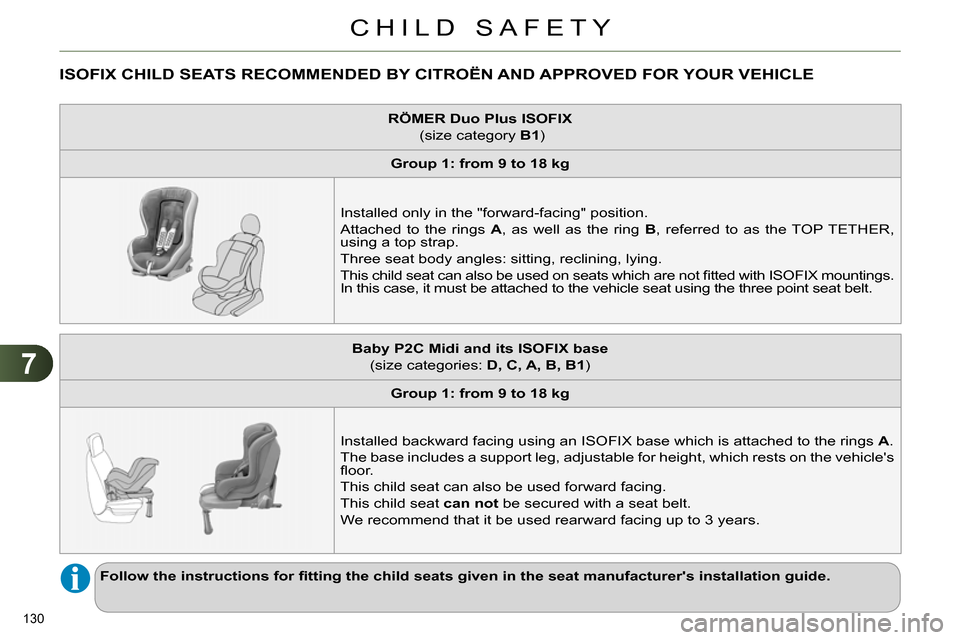
7
CHILD SAFETY
130
ISOFIX CHILD SEATS RECOMMENDED BY CITROËN AND APPROVED FOR YOUR VEHICLE
RÖMER
Duo Plus ISOFIX
(size category B1
)
Group 1: from 9 to 18 kg
Installed only in the "forward-facing" position.
Attached to the rings A
, as well as the ring B
, referred to as the TOP TETHER,
using a top strap.
Three seat body angles: sitting, reclining, lying.
This child seat can also be used on seats which are not fi tted with ISOFIX mountings.
In this case, it must be attached to the vehicle seat using the three point seat belt.
Follow the instructions for fi tting the child seats given in the seat manufacturer's installation guide.
Baby P2C Midi and its ISOFIX base
(size categories: D, C, A, B, B1
)
Group 1: from 9 to 18 kg
Installed backward facing using an ISOFIX base which is attached to the rings A
.
The base includes a support leg, adjustable for height, which rests on the vehicle's
fl oor.
This child seat can also be used forward facing.
This child seat can
not
be secured with a seat belt.
We recommend that it be used rearward facing up to 3 years.
Page 133 of 328
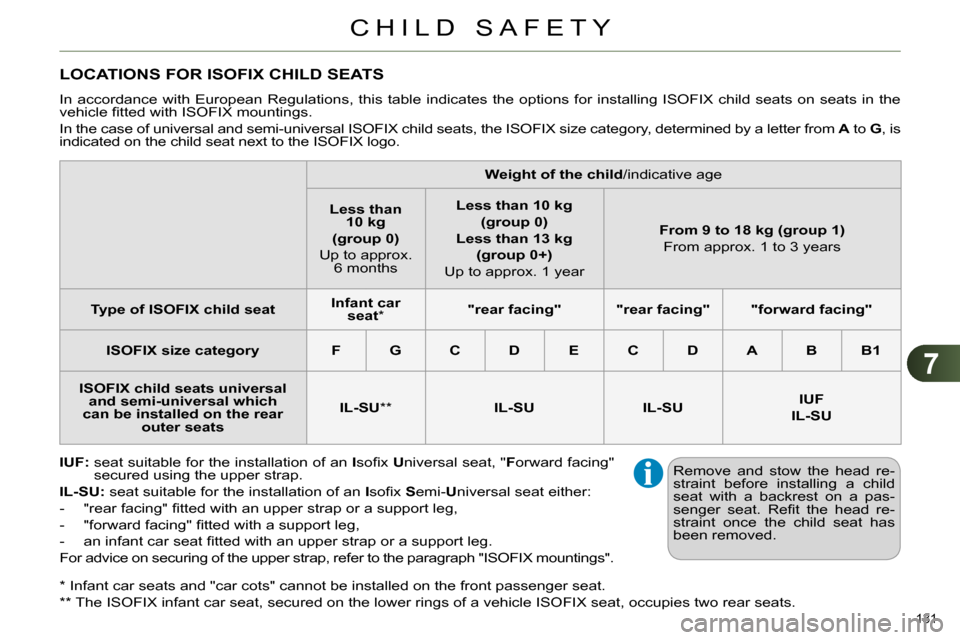
7
CHILD SAFETY
131
*
Infant car seats and "car cots" cannot be installed on the front passenger seat.
**
The ISOFIX infant car seat, secured on the lower rings of a vehicle ISOFIX seat, occupies two rear seats.
LOCATIONS FOR ISOFIX CHILD SEATS
In accordance with European Regulations, this table indicates the options for installing ISOFIX child seats on seats in the
vehicle fi tted with ISOFIX mountings.
In the case of universal and semi-universal ISOFIX child seats, the ISOFIX size category, determined by a letter from A
to G
, is
indicated on the child seat next to the ISOFIX logo.
IUF:
seat suitable for the installation of an I
sofi x U
niversal seat, " F
orward facing"
secured using the upper strap.
IL-SU:
seat suitable for the installation of an I
sofi x S
emi- U
niversal seat either:
- "rear facing" fi tted with an upper strap or a support leg,
- "forward facing" fi tted with a support leg,
- an infant car seat fi tted with an upper strap or a support leg.
For advice on securing of the upper strap, refer to the paragraph "ISOFIX mountings".
Weight of the child
/indicative age
Less than
10 kg
(group 0)
Up to approx.
6 months
Less than 10 kg
(group 0)
Less than 13 kg
(group 0+)
Up to approx. 1 year
From 9 to 18 kg (group 1)
From approx. 1 to 3 years
Type of ISOFIX child seat
Infant car
seat
*
"rear facing"
"rear facing"
"forward facing"
ISOFIX size category
F
G
C
D
E
C
D
A
B
B1
ISOFIX child seats universal
and semi-universal which
can be installed on the rear
outer seats
IL-SU
**
IL-SU
IL-SU
IUF
IL-SU
Remove and stow the head re-
straint before installing a child
seat with a backrest on a pas-
senger seat. Refi t the head re-
straint once the child seat has
been removed.
Page 134 of 328

7
CHILD SAFETY
132
For optimum installation of the "for-
ward-facing" child seat, ensure that
the back of the child seat is as close
as possible to the backrest of the ve-
hicle's seat, in contact if possible.
You mst remove the head restraint
before installing a child seat with
backrest to a passenger seat.
Ensure that the head restraint is
stored or attached securely to pre-
vent it from being thrown around the
vehicle in the event of sharp brak-
ing. Refi t the head restraint when the
child seat is removed.
ADVICE ON CHILD SEATS
Installing a booster seat
Children at the front
The incorrect installation of a child
seat in a vehicle compromises the
child's protection in the event of an
accident.
Ensure that there is no seat belt or
seat belt buckle under the child seat,
as this could destabilise it.
Remember to fasten the seat belts or
the child seat harnesses keeping the
slack relative to the child's body to a
minimum, even for short journeys.
When installing a child seat using the
seat belt, ensure that the seat belt is
tightened correctly on the child seat
and that it secures the child seat fi rm-
ly on the seat of your vehicle. If your
passenger seat is adjustable, move it
forwards if necessary.
The legislation on carrying children on
the front passenger seat is specifi c to
each country. Refer to the legislation
in force in your country.
Deactivate the passenger airbag
when a "rearward-facing" child seat
is installed on the front seat.
Otherwise, the child would risk being
seriously injured or killed if the airbag
were to infl ate.
The chest part of the seat belt must
be positioned on the child's shoulder
without touching the neck.
Ensure that the lap part of the seat
belt passes correctly over the child's
thighs.
CITROËN recommends the use of
a booster seat which has a back, fi t-
ted with a seat belt guide at shoulder
level.
As a safety precaution, do not leave:
- a child or children alone and un-
supervised in a vehicle,
- a child or an animal in a vehicle
which is exposed to the sun, with
the windows closed,
- the keys within reach of children
inside the vehicle.
At rear seating positions, always
leave suffi cient space between the
front seat and:
- a "rearwards facing" child seat,
- the child's feet for a child seat fi t-
ted "forwards facing".
To do this, move the front seat for-
wards and, if necessary, move its
backrest into the upright position. To prevent accidental opening of the
doors and rear windows, use the
"Child lock".
Take care not to open the rear win-
dows by more than one third.
To protect young children from the
rays of the sun, fi t side blinds on the
rear windows.
Page 135 of 328
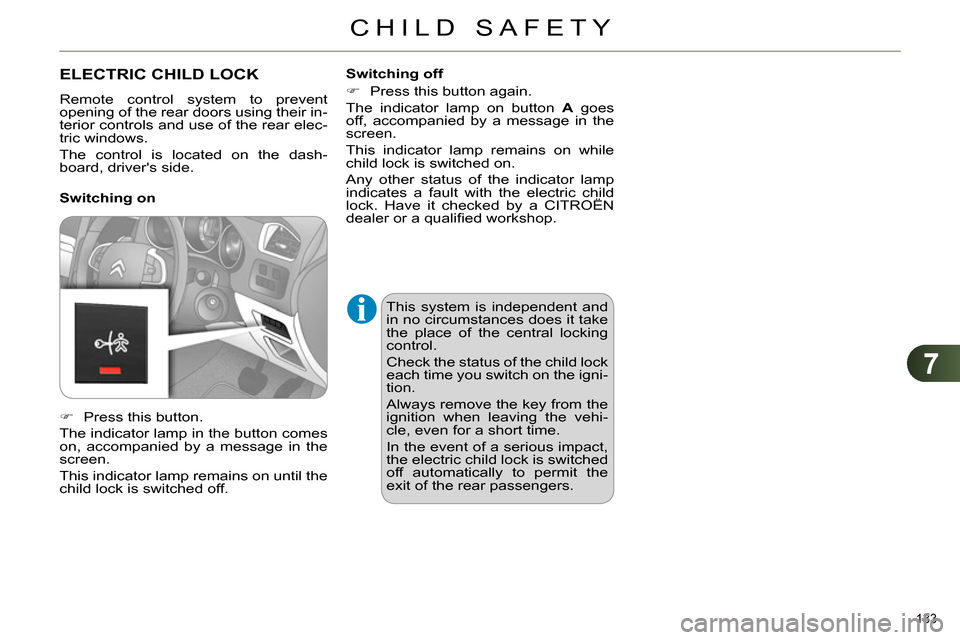
7
CHILD SAFETY
133
ELECTRIC CHILD LOCK
Remote control system to prevent
opening of the rear doors using their in-
terior controls and use of the rear elec-
tric windows.
The control is located on the dash-
board, driver's side.
Press this button.
The indicator lamp in the button comes
on, accompanied by a message in the
screen.
This indicator lamp remains on until the
child lock is switched off.
Switching on
Switching off
Press this button again.
The indicator lamp on button A
goes
off, accompanied by a message in the
screen.
This indicator lamp remains on while
child lock is switched on.
Any other status of the indicator lamp
indicates a fault with the electric child
lock. Have it checked by a CITROËN
dealer or a qualifi ed workshop.
This system is independent and
in no circumstances does it take
the place of the central locking
control.
Check the status of the child lock
each time you switch on the igni-
tion.
Always remove the key from the
ignition when leaving the vehi-
cle, even for a short time.
In the event of a serious impact,
the electric child lock is switched
off automatically to permit the
exit of the rear passengers.
Page 136 of 328
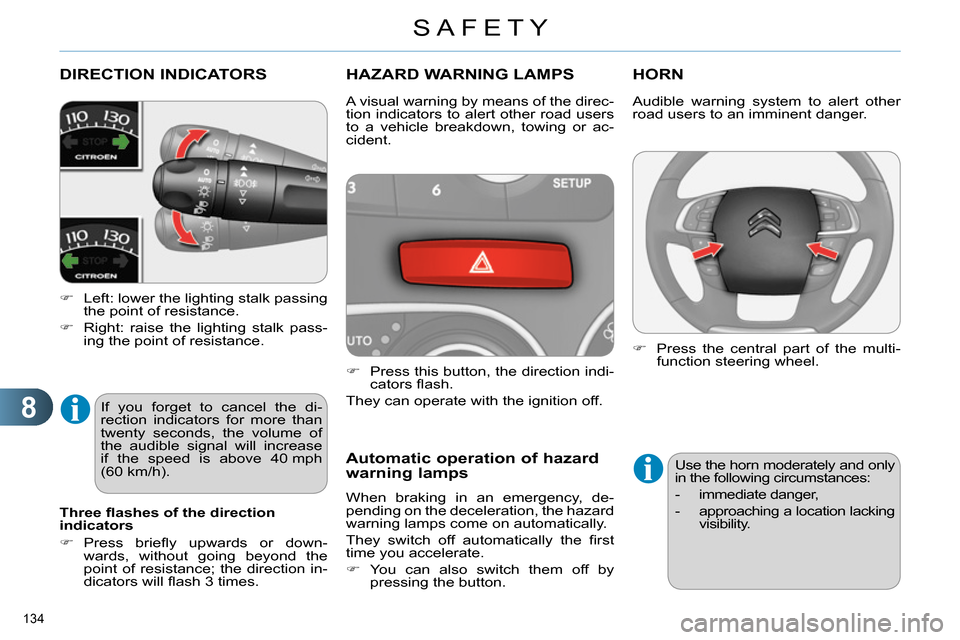
8
SAFETY
134
DIRECTION INDICATORS
Left: lower the lighting stalk passing
the point of resistance.
Right: raise the lighting stalk pass-
ing the point of resistance.
HAZARD WARNING LAMPS
Press this button, the direction indi-
cators fl ash.
They can operate with the ignition off.
Automatic operation of hazard
warning lamps
When braking in an emergency, de-
pending on the deceleration, the hazard
warning lamps come on automatically.
They switch off automatically the fi rst
time you accelerate.
You can also switch them off by
pressing the button.
HORN
A visual warning by means of the direc-
tion indicators to alert other road users
to a vehicle breakdown, towing or ac-
cident.
Three fl ashes of the direction
indicators
Press briefl y upwards or down-
wards, without going beyond the
point of resistance; the direction in-
dicators will fl ash 3 times.
If you forget to cancel the di-
rection indicators for more than
twenty seconds, the volume of
the audible signal will increase
if the speed is above 40 mph
(60 km/h). Audible warning system to alert other
road users to an imminent danger.
Press the central part of the multi-
function steering wheel.
Use the horn moderately and only
in the following circumstances:
- immediate danger,
- approaching a location lacking
visibility.
Page 137 of 328
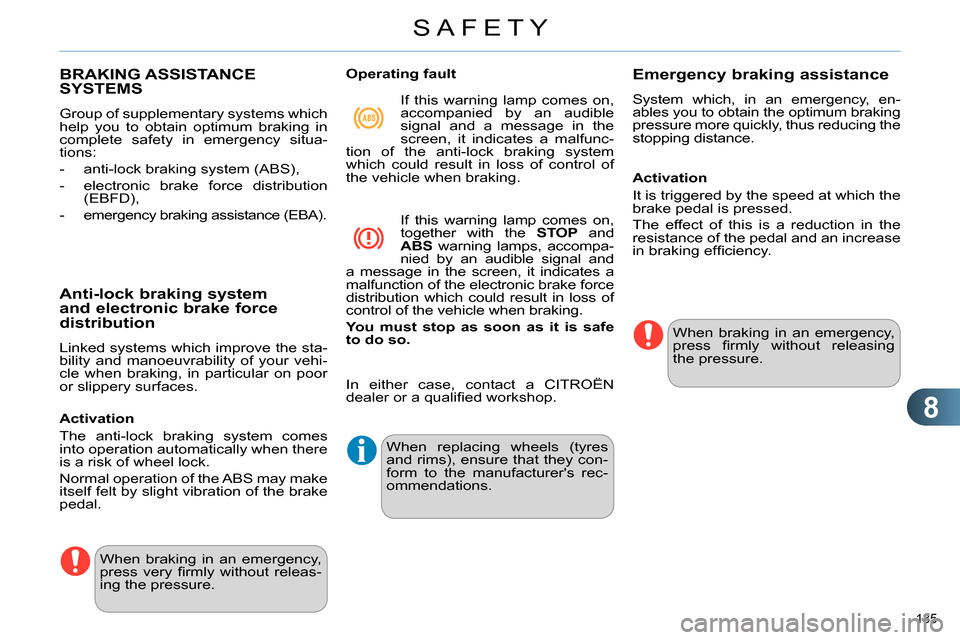
8
SAFETY
135
BRAKING ASSISTANCE
SYSTEMS
Group of supplementary systems which
help you to obtain optimum braking in
complete safety in emergency situa-
tions:
- anti-lock braking system (ABS),
- electronic brake force distribution
(EBFD),
- emergency braking assistance (EBA).
When braking in an emergency,
press very fi rmly without releas-
ing the pressure.
When replacing wheels (tyres
and rims), ensure that they con-
form to the manufacturer's rec-
ommendations.
When braking in an emergency,
press fi rmly without releasing
the pressure.
Anti-lock braking system
and electronic brake force
distribution
Linked systems which improve the sta-
bility and manoeuvrability of your vehi-
cle when braking, in particular on poor
or slippery surfaces.
Activation
The anti-lock braking system comes
into operation automatically when there
is a risk of wheel lock.
Normal operation of the ABS may make
itself felt by slight vibration of the brake
pedal.
Operating fault
If this warning lamp comes on,
accompanied by an audible
signal and a message in the
screen, it indicates a malfunc-
tion of the anti-lock braking system
which could result in loss of control of
the vehicle when braking.
If this warning lamp comes on,
together with the STOP
and
ABS
warning lamps, accompa-
nied by an audible signal and
a message in the screen, it indicates a
malfunction of the electronic brake force
distribution which could result in loss of
control of the vehicle when braking.
You must stop as soon as it is safe
to do so.
Emergency braking assistance
System which, in an emergency, en-
ables you to obtain the optimum braking
pressure more quickly, thus reducing the
stopping distance.
Activation
It is triggered by the speed at which the
brake pedal is pressed.
The effect of this is a reduction in the
resistance of the pedal and an increase
in braking effi ciency.
In either case, contact a CITROËN
dealer or a qualifi ed workshop.
Page 138 of 328
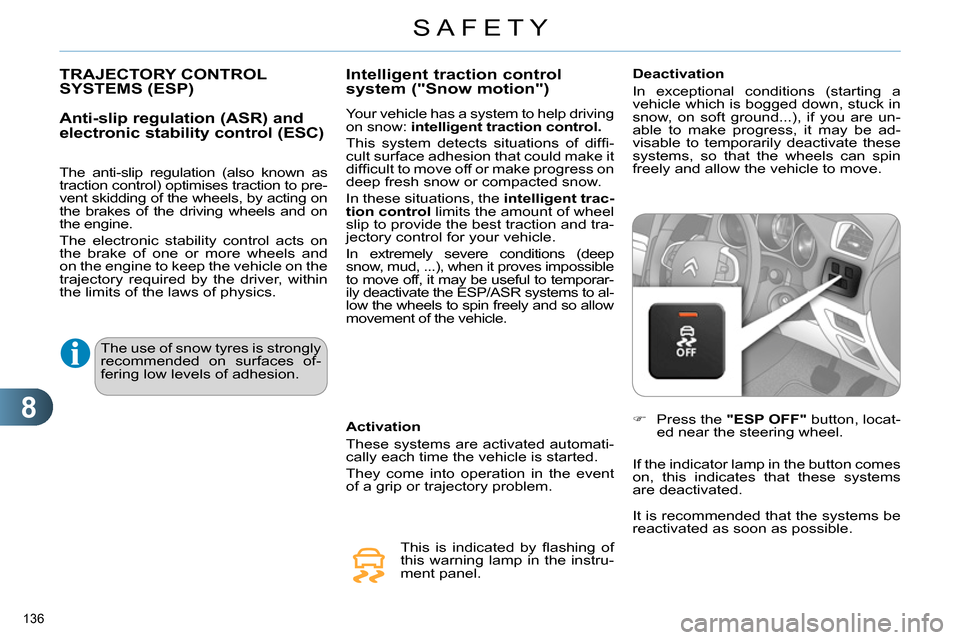
8
SAFETY
136
TRAJECTORY CONTROL
SYSTEMS (ESP)
Anti-slip regulation (ASR) and
electronic stability control (ESC)
The anti-slip regulation (also known as
traction control) optimises traction to pre-
vent skidding of the wheels, by acting on
the brakes of the driving wheels and on
the engine.
The electronic stability control acts on
the brake of one or more wheels and
on the engine to keep the vehicle on the
trajectory required by the driver, within
the limits of the laws of physics.
Activation
These systems are activated automati-
cally each time the vehicle is started.
They come into operation in the event
of a grip or trajectory problem.
This is indicated by fl ashing of
this warning lamp in the instru-
ment panel.
Intelligent traction control
system ("Snow motion")
Your vehicle has a system to help driving
on snow: intelligent traction control.
This system detects situations of diffi -
cult surface adhesion that could make it
diffi cult to move off or make progress on
deep fresh snow or compacted snow.
In these situations, the intelligent trac-
tion control
limits the amount of wheel
slip to provide the best traction and tra-
jectory control for your vehicle.
In extremely severe conditions (deep
snow, mud, ...), when it proves impossible
to move off, it may be useful to temporar-
ily deactivate the ESP/ASR systems to al-
low the wheels to spin freely and so allow
movement of the vehicle.
Deactivation
In exceptional conditions (starting a
vehicle which is bogged down, stuck in
snow, on soft ground...), if you are un-
able to make progress, it may be ad-
visable to temporarily deactivate these
systems, so that the wheels can spin
freely and allow the vehicle to move.
Press the "ESP OFF"
button, locat-
ed near the steering wheel.
If the indicator lamp in the button comes
on, this indicates that these systems
are deactivated.
The use of snow tyres is strongly
recommended on surfaces of-
fering low levels of adhesion.
It is recommended that the systems be
reactivated as soon as possible.
Page 139 of 328
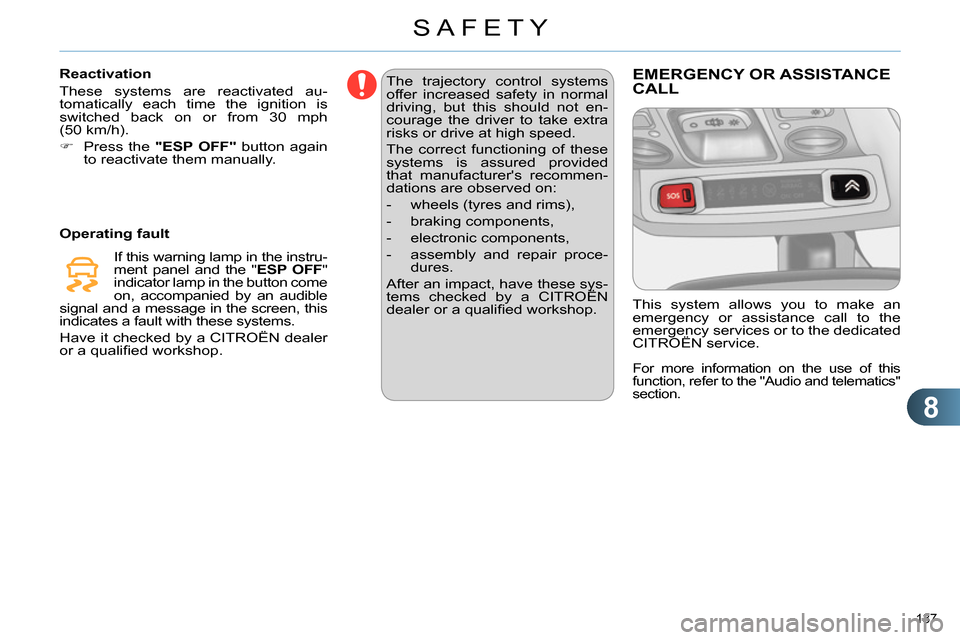
8
SAFETY
137
The trajectory control systems
offer increased safety in normal
driving, but this should not en-
courage the driver to take extra
risks or drive at high speed.
The correct functioning of these
systems is assured provided
that manufacturer's recommen-
dations are observed on:
- wheels (tyres and rims),
- braking components,
- electronic components,
- assembly and repair proce-
dures.
After an impact, have these sys-
tems checked by a CITROËN
dealer or a qualifi ed workshop.
Reactivation
These systems are reactivated au-
tomatically each time the ignition is
switched back on or from 30 mph
(50 km/h).
Press the "ESP OFF"
button again
to reactivate them manually.
If this warning lamp in the instru-
ment panel and the " ESP OFF
"
indicator lamp in the button come
on, accompanied by an audible
signal and a message in the screen, this
indicates a fault with these systems.
Have it checked by a CITROËN dealer
or a qualifi ed workshop.
Operating fault
EMERGENCY OR ASSISTANCE
CALL
This system allows you to make an
emergency or assistance call to the
emergency services or to the dedicated
CITROËN service.
For more information on the use of this
function, refer to the "Audio and telematics"
section.
Page 140 of 328
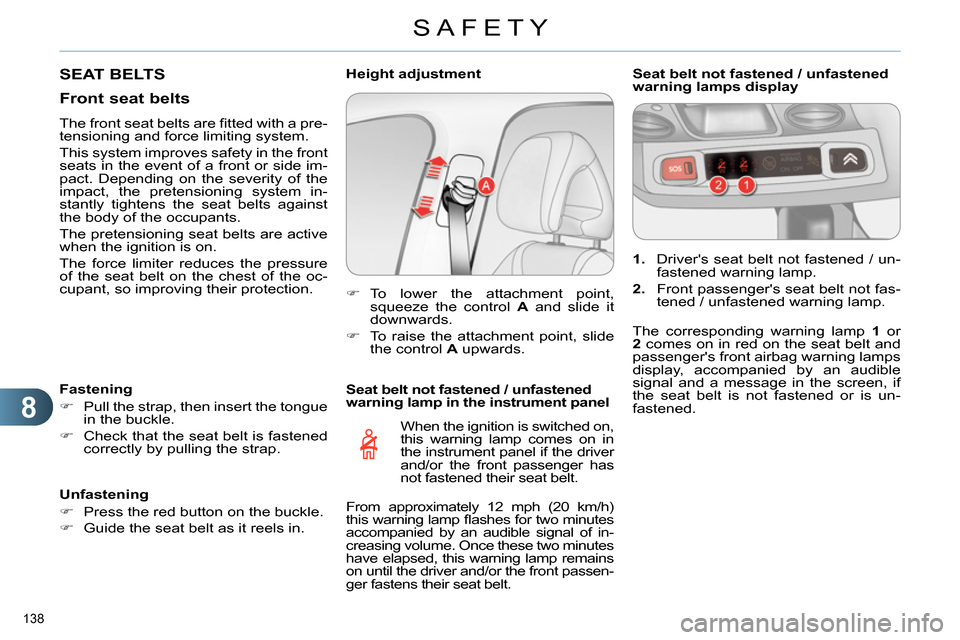
8
SAFETY
138
Seat belt not fastened / unfastened
warning lamp in the instrument panel
When the ignition is switched on,
this warning lamp comes on in
the instrument panel if the driver
and/or the front passenger has
not fastened their seat belt.
1.
Driver's seat belt not fastened / un-
fastened warning lamp.
2.
Front passenger's seat belt not fas-
tened / unfastened warning lamp.
Seat belt not fastened / unfastened
warning lamps display
To lower the attachment point,
squeeze the control A
and slide it
downwards.
To raise the attachment point, slide
the control A
upwards.
Height adjustment
SEAT BELTS
Front seat belts
The front seat belts are fi tted with a pre-
tensioning and force limiting system.
This system improves safety in the front
seats in the event of a front or side im-
pact. Depending on the severity of the
impact, the pretensioning system in-
stantly tightens the seat belts against
the body of the occupants.
The pretensioning seat belts are active
when the ignition is on.
The force limiter reduces the pressure
of the seat belt on the chest of the oc-
cupant, so improving their protection.
Fastening
Pull the strap, then insert the tongue
in the buckle.
Check that the seat belt is fastened
correctly by pulling the strap.
Unfastening
Press the red button on the buckle.
Guide the seat belt as it reels in.
The corresponding warning lamp 1
or
2
comes on in red on the seat belt and
passenger's front airbag warning lamps
display, accompanied by an audible
signal and a message in the screen, if
the seat belt is not fastened or is un-
fastened.
From approximately 12 mph (20 km/h)
this warning lamp fl ashes for two minutes
accompanied by an audible signal of in-
creasing volume. Once these two minutes
have elapsed, this warning lamp remains
on until the driver and/or the front passen-
ger fastens their seat belt.